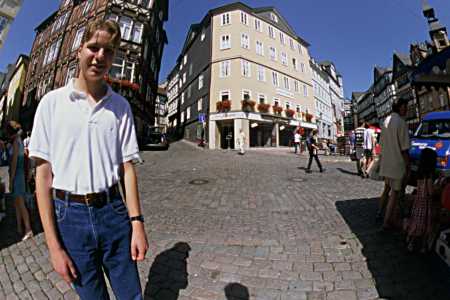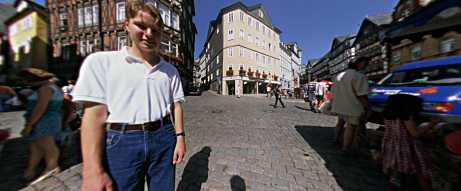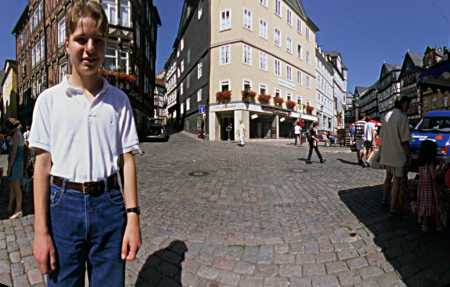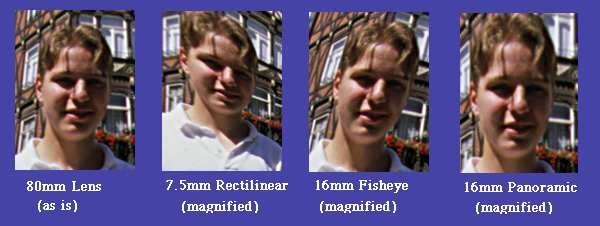Wide Angle Perspective
H. Dersch
Technical University Furtwangen
der@fh-furtwangen.de
15. September 1998
In Photography the question of perspective arises when wide angle scenes
have to be imaged. The normal, rectilinear perspective is technically limited
to angles smaller than 180 degrees (in practice much smaller than that).
Competing are the panoramic perspective, which horizontally is unlimited,
vertically identical to the rectilinear, and the fisheye perspective which
is unlimited in either direction.
To recover the original view, a rectilinear image has to be viewed on
a flat surface, the panoramic image on a cylindrical surface, and the fisheye-image
on a (near) spherical surface. In each case the viewer has to assume a
well defined position relative to the image.
There are fierce debates going on (and this article arose from one)
about which one is the appropriate, or most natural method. I am biased
towards the answer that none is perfect and each method has its merits,
but I want to provide some exaggerated example images to visualize the
arguments.
The image I have choosen is a partial view of a full-spherical panorama,
which is part of my Virtual
Tour of Marburg. The full view can be observed at my website. I selected
a 135° horizontal part, which corresponds to the coverage of a full-frame
fisheye lens (15/16mm for 35mm equipment). To roughly get the same field
of view with a rectilinear lens, we need a (not-existant, but easily calculated)
7.5mm rectilinear lens, or a panoramic swing-lens camera equipped with
a 16mm lens. The three images were calculated using my program "Panorama
Tools" and are displayed below:
 Full-Frame Fisheye (16mm)
Full-Frame Fisheye (16mm)
 Rectilinear lens (7.5mm)
Rectilinear lens (7.5mm)
 Swing-lens or Scanning-Slit Panoramic Image (16mm lens)
While the centers of the images do not differ much, there are more drastic
changes at the edges. To make this clear I have magnified an identical
portion (the portrait of the young man, who happens to be my son Rick)
and compared it with the usual portrait perspective (80mm telephoto lens).
Swing-lens or Scanning-Slit Panoramic Image (16mm lens)
While the centers of the images do not differ much, there are more drastic
changes at the edges. To make this clear I have magnified an identical
portion (the portrait of the young man, who happens to be my son Rick)
and compared it with the usual portrait perspective (80mm telephoto lens).

Some remarks and conclusions:
-
Images are usually viewed as flat prints or slides. It therefore seems
obvious that the rectilinear perspective, which technically provides a
perfect rendering of the scene when viewed as flat image, should be
most pleasing. Clearly, this is not the case. Why?
-
We don't view the image from the right distance: On a normal 72dpi screen
this would be 3.2cm = 1.3inches, very uncomfortable indeed. And viewed
from the wrong distance, a rectilinear image looks obviously very unnatural.
-
Even when viewed from the right distance, we can not keep the whole image
in focus at the same time. This adds to the unnatural effect.
-
To me, small objects (eg the portrait) look more natural in the fisheye
image than in the rectilinear view, while large objects (eg the buildings)
look more natural in the rectilinear image. The panoramic projection is
an interesting compromise.
-
Our own eyes create an intermediate 2D-representation of the 3D-world,
which is not rectilinear. This manifests itself in certain optical illusions,
eg off-axis straight lines sometimes appear bent etc. This makes many people
believe (I found references in several popular books on photography as
well as in the internet) that
this somehow proofs fisheye images to be more natural. I strongly disagree
with this view for several reasons:
-
Viewed from the wrong distance (as we all do when viewing the above
images) the fisheye image appears to be more natural in rendering details
like the portrait than the rectilinear image. This would be perceived by
any viewer, even a robot or alien with rectilinear vision system.
-
The optical illusions mentioned above are faithfully replicated when viewing
any of the above projections the right way (as described at the beginning).
Each fails when viewed wrongly (ie the fisheye image on flat surfaces,
and the rectilinear image from the wrong distance).
-
So this really is very simple geometry, and we don't have to resort to
the details of our vision apparatus to explain them.
Other than that it is pure personal taste and preference (probably also
depending on the subject) which projection better visualizes a wide
angle scene. None does it 100% correct. And since we all have computers
today, we can simply change the projection from one type to the other as
I did in this article using Panorama
Tools. So in buying equipment we can choose the cheapest one (which
is the Fisheye lens).
Thanks to David Ruether (ruether@fcinet.com ), who does not agree with
this view, for a stimulating discussion.
Copyright 1998 © Helmut Dersch